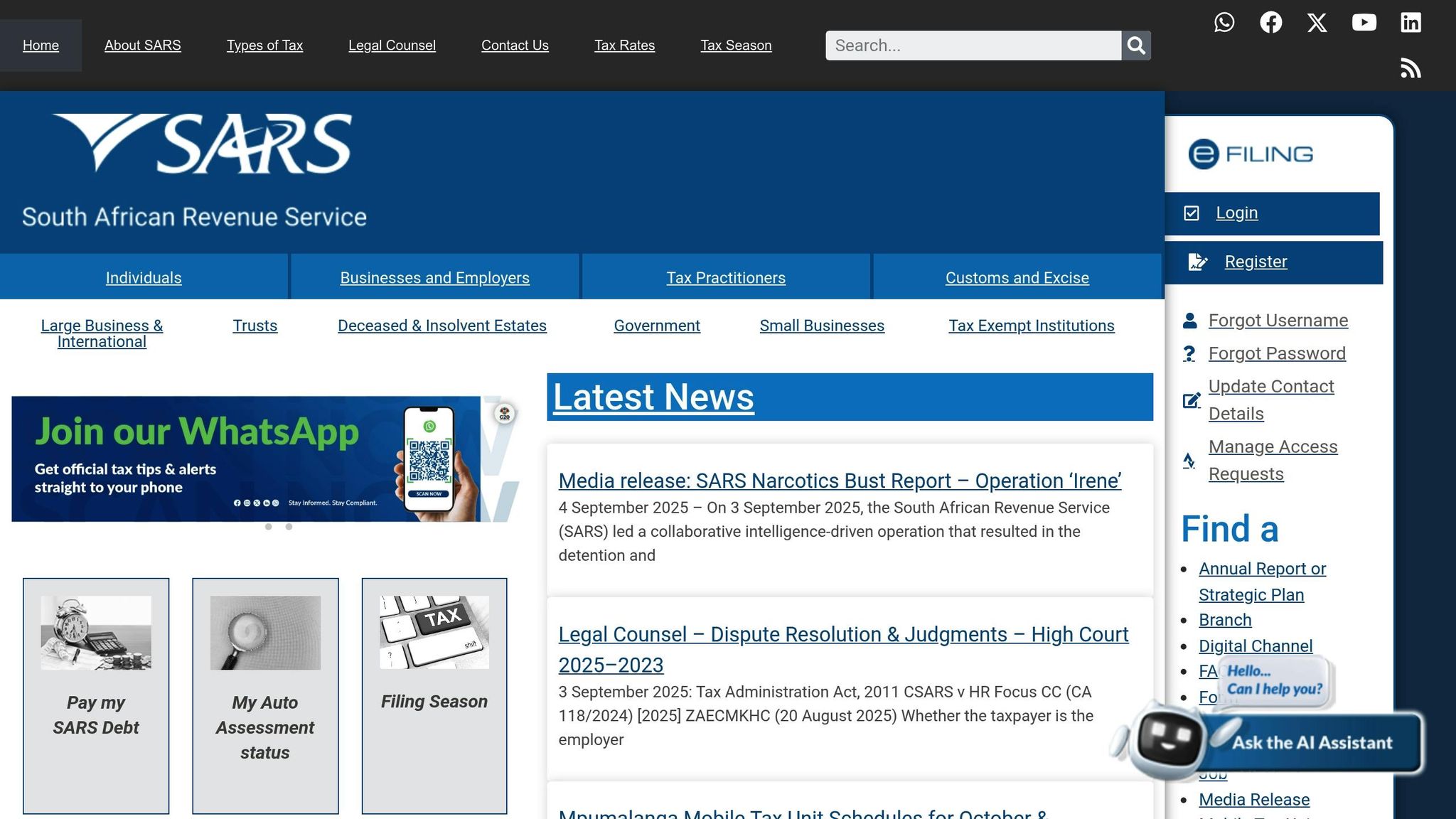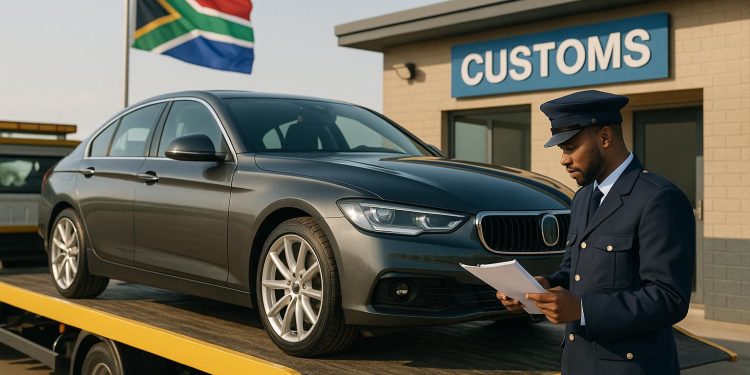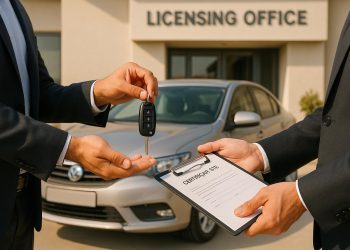Importing a car into South Africa is a complex process with multiple taxes, permits, and regulations. Here’s what you need to know:
- Taxes to Budget For:
- Customs Duty: Up to 36% for cars under 20 years old; 20% for older vehicles.
- Ad Valorem Duty: 0.75%–20% based on the car’s value.
- VAT: 15% on the total of CIF (Cost, Insurance, Freight) value and duties.
- Other Levies: Possible additional charges like anti-dumping duties or emissions-related fees.
- Key Documents Required:
- Steps to Import:
- Get the necessary permits and documents before shipping.
- Calculate duties based on CIF value.
- Submit the DA 185 Customs Declaration within 30 days of arrival.
- Pay all duties electronically.
- Clear the vehicle at the port and complete registration within 21 days.
- Exemptions: Returning residents and immigrants may qualify for duty and VAT exemptions for one vehicle, but strict conditions apply.
Tip: Mistakes in paperwork or underestimating costs can lead to delays and extra expenses. Working with a trusted clearing agent or consultant can help ensure compliance with SARS regulations.
Bringing a car into South Africa can cost over 65% of its value in taxes and fees, so plan carefully before starting the process.
SARS Taxes and VAT on Imported Vehicles

Customs Duty and CIF Value
When importing a vehicle into South Africa, customs duty is calculated based on the CIF value – short for Cost, Insurance, and Freight. This value combines the vehicle’s purchase price, shipping costs, and insurance expenses incurred during transit to South Africa.
SARS (South African Revenue Service) uses the CIF value as the foundation for determining tax obligations. The exact customs duty rate varies depending on factors like the vehicle’s age and classification. Typically, newer vehicles are subject to higher duty rates, while older models may qualify for lower rates. It’s important to note that SARS determines a vehicle’s age by its manufacturing year, not the model year, so double-check this detail before importing. This initial customs duty calculation sets the stage for additional taxes.
VAT on Imported Vehicles
After customs duty is determined, VAT (Value-Added Tax) is applied. VAT is charged at 15% on the combined total of the CIF value and any applicable duties. This adds a substantial amount to the overall cost of importing a vehicle.
Other Taxes You May Pay
In addition to customs duty and VAT, there are other potential taxes and levies that could apply, depending on the vehicle’s origin and specifications. These may include:
- Ad valorem duties: Taxes based on the value of the vehicle (see earlier sections for more details).
- Anti-dumping duties: Applied to imports from regions where pricing is deemed unfair or below market value.
- Environmental levies: Charged on vehicles that fail to meet emission standards.
- Excise duties: Based on factors like engine size, fuel type, or luxury features.
These extra charges can significantly increase the cost of importing a vehicle. To avoid surprises, it’s essential to research and budget for all potential fees and taxes ahead of time.
How to Import and Clear Vehicles: Step-by-Step Guide
What You Need Before Importing
Before starting the import process, make sure you have the following documents ready: an ITAC import permit, the original title or ownership certificate, a bill of sale, a financing authorization (if applicable), a roadworthiness certificate (for vehicles over five years old), and transit insurance documentation.
The ITAC import permit is essential and must be obtained before shipping. It specifies the exact vehicle you are allowed to import, including details like the VIN number, make, model, and year.
The original title or certificate of ownership from the vehicle’s country of origin is required, along with a bill of sale that shows the purchase price. These documents help SARS verify ownership and calculate the CIF (Cost, Insurance, and Freight) value. If the vehicle is financed, you’ll also need a letter of authorization from your financing institution.
If the vehicle is over five years old, a roadworthiness certificate is mandatory. This certificate, issued by an authorized testing station in the country of origin, confirms that the vehicle meets South African safety standards. Without it, customs clearance won’t be possible.
You’ll also need transit insurance documentation, which covers the vehicle during shipping. This insurance must include the coverage amount and shipping duration, as it factors into the CIF value calculation.
Customs Declaration and Paying Duties
Once the vehicle arrives, you’ll need to complete the DA 185 Customs Declaration. This can be done through SARS eFiling or with the help of a registered clearing agent. Make sure to complete this step within 30 days of the vehicle’s arrival.
SARS will assess the vehicle’s CIF value and may request additional documents if the declared value doesn’t align with market rates for similar vehicles. The evaluation process typically takes 5-7 business days for standard vehicles, though it may take longer for luxury or rare models.
Duties must be paid electronically, as cash payments are not accepted. After payment, you’ll receive a confirmation number, which you’ll need when collecting your vehicle.
The total payable amount includes customs duty, VAT (15%), and any additional levies. For example, if your vehicle has a CIF value of $25,000 and a 25% duty rate, you’ll pay $6,250 in customs duty. Add to that $4,687.50 in VAT (15% of $31,250), bringing the total taxes to $10,937.50.
Once you’ve settled the duties, you can move on to port clearance and registration.
Port Clearance and Vehicle Registration
With customs requirements completed, the next step is clearing the port and registering your vehicle.
After confirming payment, visit the port for a vehicle inspection. Officials will verify the VIN, engine number, and the vehicle’s condition against your documentation.
If the vehicle lacks recognized international certification, the South African Bureau of Standards (SABS) may require additional testing. This process can take 10-14 days and costs between $500 and $800, depending on the tests needed.
Once the vehicle is cleared from the port, you have 21 days to register it with your local licensing department. To register, you’ll need the SARS clearance certificate, the roadworthiness certificate, and proof of South African residence or a work permit if you’re a foreign national.
Registration fees vary by province, typically ranging from $150 to $300. You’ll also need South African vehicle insurance, as proof of coverage is required for licensing.
Finally, you’ll need to get license plates and update the registration in the National Traffic Information System (NaTIS). This step usually takes 2-3 business days, completing the process to legally drive your vehicle on South African roads.
Importing Japanese Cars to South Africa + Cost – LiveStream
sbb-itb-09752ea
Duty Exemptions and Special Cases
Some individuals can benefit from duty and VAT exemptions when importing vehicles, which can lead to significant savings for those who meet the criteria.
Exemptions for Returning Residents and Immigrants
Returning residents and new immigrants are entitled to duty and VAT exemptions for one vehicle. To qualify, applicants need to provide the necessary documentation as required by South African authorities. This process generally includes securing a Letter of Authority (LOA) from the National Regulator for Compulsory Specifications, along with any other supporting paperwork specified by the relevant agencies.
There are also additional provisions, such as rebates for car manufacturers and specific rules for electric vehicles, that form part of South Africa’s import regulations.
How to Stay Compliant and Avoid Problems
Navigating the import process can be tricky. Complex rules and regulations can lead to delays, penalties, or even outright rejection of your application. Even minor errors can derail the entire process. Knowing the common pitfalls and taking proactive steps can save you a lot of time, money, and stress.
Common Import Problems
Documentation errors are a major cause of delays and penalties. Mistakes like using incorrect tariff codes or submitting incomplete paperwork can lead to higher duties and permit delays. Another common oversight is failing to confirm eligibility for a Letter of Authority (LOA) from the National Regulator for Compulsory Specifications (NRCS) early in the process.
Vehicle compliance issues can stop your import in its tracks. Vehicles that don’t meet South African roadworthiness and emissions standards often face permit denials and registration problems. One of the most frequent mistakes is trying to import left-hand drive vehicles, which are not allowed for public road use in South Africa.
Financial miscalculations often catch importers by surprise. Many overlook the full range of costs, such as customs duty, ad valorem duty, and VAT, which can add significantly to the vehicle’s price. Those seeking duty exemptions sometimes fail to meet the strict conditions, resulting in backdated taxes and penalties.
Fraudulent transactions are another risk. Scams involving unverified overseas dealers can leave importers without their money or vehicle. Importing grey vehicles through unofficial channels also poses risks, as these vehicles often bypass safety checks, lack service history, and may be difficult to repair due to unavailable parts.
Tips for Smooth Vehicle Imports
To avoid these issues, follow these key steps:
- Double-check all documentation before submitting your application. Ensure paperwork is accurate and uses the correct tariff codes to avoid delays or higher duties. Obtain your Import Permit from the International Trade Administration Commission (ITAC) and confirm your LOA eligibility with the NRCS as early as possible.
- Research your vehicle thoroughly. Make sure it complies with South African roadworthiness and emissions standards. Stick to right-hand drive models, as left-hand drive vehicles are generally not allowed. When buying from overseas, verify the seller’s contact details and reputation through platforms like Trustpilot or Google.
- Work with trusted professionals who understand the import process. Vehicle import consultants, customs agents, or verified exporters can help you avoid scams and ensure compliance. If using a clearing agent, provide a power of attorney and ensure SARS has a certified copy, keeping the original on hand for inspections.
- Budget for all costs. Go beyond the purchase price to include shipping, insurance, duties, taxes, and registration fees. Be cautious of deals that seem too good to be true, as they often hide compliance issues or other problems. For used vehicles, request verified service history and confirm mileage to avoid unpleasant surprises.
- Plan ahead. Have all required documents and payments ready for customs clearance and delivery. If applying for duty exemption, prepare proof of ownership and usage, and commit to not selling the vehicle for at least two years as required.
Where to Find Current Information
To stay updated on the latest regulations and guidance, consult these resources:
- The SARS website is your go-to source for customs forms, duty rates, and procedural updates. Since tax rates and import rules can change, always verify the latest requirements before starting your import process.
- The National Regulator for Compulsory Specifications (NRCS) provides detailed information on vehicle compliance standards and LOA requirements. Their website contains the most current technical specifications and approval procedures.
- The International Trade Administration Commission (ITAC) offers guidance on import permits and trade regulations. Check their site for up-to-date application procedures.
- Professional clearing agents and import consultants often stay informed about regulatory changes and can provide valuable advice. However, it’s always wise to cross-check their recommendations with official government sources.
If you run into issues during the import process, SARS has formal dispute resolution options. You can file disputes for customs offenses or penalties using form DA 51 for administrative appeals or form DA 52 for Alternative Dispute Resolution (ADR) applications. In cases of non-compliance due to circumstances like natural disasters, serious illness, SARS errors, or financial hardship, you may also request a waiver of interest or penalties.
Staying informed and prepared can make the import process much smoother and protect your investment.
Conclusion
Bringing a car into South Africa is often more complicated and expensive than it seems at first glance. The process demands careful planning and strict compliance with regulations. With South Africa rated as a ‘D’ for ease of importing due to its intricate procedures and rigid SARS tariff codes, success hinges on understanding every step of the process.
The financial implications are no small matter. Costs can climb to over 65% of the vehicle’s value. Taxes include Customs Duty of up to 36%, Ad Valorem Duty ranging from 0.75% to 20%, and VAT at 15%, all of which can quickly add up to a hefty expense.
Before shipping your car, securing the Letter of Authority (LOA) from the NRCS and an Import Permit from ITAC is non-negotiable. Without these documents, customs clearance is impossible, no matter how much you’ve already spent.
Some returning residents and immigrants may qualify for exemptions from duty and VAT, but the requirements are strict. These exemptions primarily apply to returning South African residents, bona fide immigrants, and specific vehicle types, such as racing, vintage, disabled, or inherited vehicles.
Even after clearing customs, the process isn’t over. You’ll still need to register the vehicle and ensure it passes a roadworthiness test before it’s legally allowed on South African roads. Missteps like missing paperwork, incorrect tariff codes, or underestimating the total costs can derail the entire effort.
Given the complexity and high stakes, working with seasoned professionals and staying up to date with SARS regulations can make all the difference. Investing in expert guidance often saves money by avoiding costly errors and delays. By adhering to these guidelines, importers can better navigate South Africa’s challenging import process.
FAQs
What challenges should I watch out for when importing a car to South Africa?
Importing a car into South Africa isn’t always straightforward. Common hurdles include submitting paperwork that’s incomplete or incorrect, which can lead to delays or unexpected fees. Another frequent issue is misclassifying the vehicle’s tariff code, potentially resulting in higher import duties. Additionally, cars that don’t meet South Africa’s safety or emissions standards risk being rejected or incurring fines.
To steer clear of these problems, double-check that all your documentation is accurate and complete. Ensure the vehicle meets local safety and emissions requirements, and always go through authorized importation channels. A bit of preparation and careful attention to detail can make the process much smoother.
Am I eligible for duty and VAT exemptions when bringing my car to South Africa as a returning resident or immigrant?
If you’re a returning resident or an immigrant, you might be eligible for duty and VAT exemptions when bringing your vehicle into South Africa. To qualify, you’ll need to meet these important criteria:
- Permanent Residency: You must have established permanent residency in South Africa.
- Vehicle Ownership: The vehicle must have been owned and used by you for at least 12 months prior to shipping.
- Proof of Foreign Residency: Documents like a passport or a South African ID must show you resided abroad for at least six months.
Having these documents in order is crucial to ensure a smooth process for duty-free importation and VAT exemptions.
What do I need to do to ensure my car meets South Africa’s roadworthiness and emissions standards before importing?
Before bringing your car into South Africa, ensure it aligns with the country’s roadworthiness and emissions regulations. This means the vehicle must pass a roadworthiness inspection and adhere to emissions standards at least equivalent to Euro II (though future updates may require compliance with Euro V). Additionally, the car must be right-hand drive.
To confirm compliance, you’ll need a Certificate of Conformity. It’s also a good idea to obtain a Letter of Authority (LOA) from the National Regulator for Compulsory Specifications (NRCS). This document verifies that your vehicle meets all necessary safety and emissions standards, helping to streamline the import process.
Related Blog Posts
- Age-Based Import Taxes for Used Cars in South Africa
- South Africa’s Vehicle Import Tariffs Explained
- EV Import Duties in South Africa Explained
- How Much Does It Really Cost to Import a Car into South Africa?





